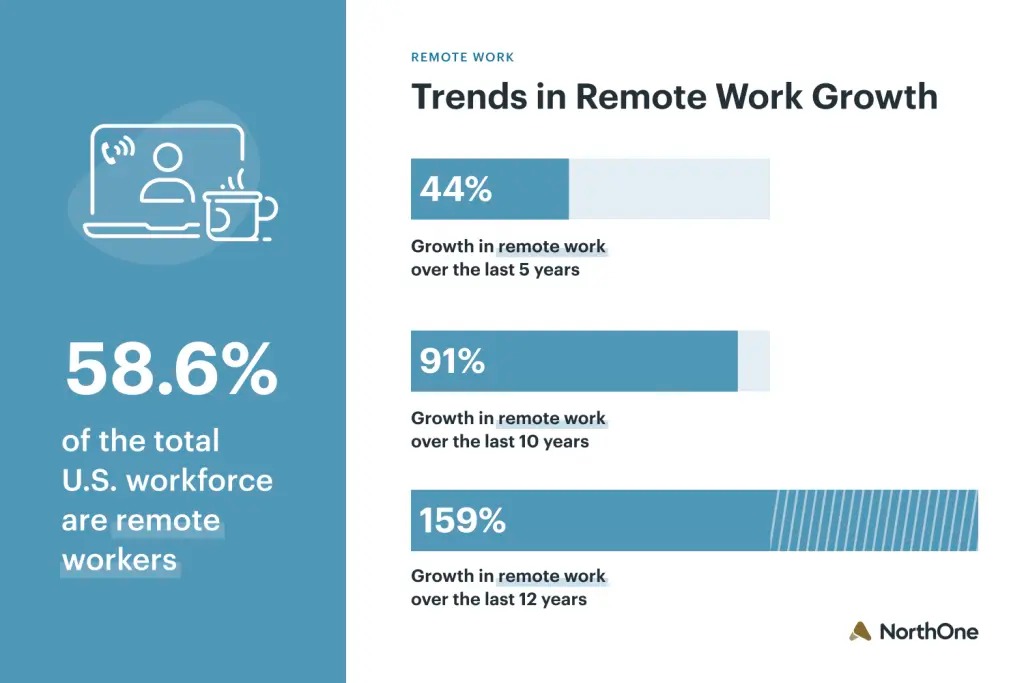 News
News
Retaining remote software developers has evolved from a logistical challenge into a strategic move that’s key to staying ahead of the competition. With 74% of tech companies now embracing remote work, the need for effective retention strategies among distributed teams is more pressing than ever - especially considering the recent swings of the IT job market like The Great Resignation and the Tech Bubble Burst. This article dives deep into the effort of keeping your remote developers engaged, motivated, and loyal to retain top tech talent more easily. Keep reading to learn more!
The Current Remote Software Development Landscape
The remote software development sector is evolving rapidly, reshaping how businesses operate and developers work. With the surge in digital transformation propelled by the COVID-19 pandemic, an estimated 16% of companies globally are now fully remote, signaling a significant shift towards a more flexible work model. This trend is not just a reaction to global disruptions but a testament to the growing recognition of remote work's benefits, including increased productivity, access to a wider talent pool, and cost savings on office space.

Remote work has opened doors to unprecedented collaboration opportunities for distributed tech teams. Developers from across the globe can now contribute to projects, bringing diverse perspectives and expertise to the table. This has led to a surge in innovation, with companies leveraging this distributed model to accelerate product development cycles and improve software quality.
Beyond cost savings, the benefits of remote software development for international IT professionals are compelling. A study revealed that remote developers are 20% more likely to report higher job satisfaction compared to their in-office counterparts, highlighting the positive impact of remote work on employee well-being and retention. To thrive while incorporating a remote team, businesses must adopt a strategic approach to remote work, embracing technology, fostering communication, and building a culture that supports remote engagement.
Why It’s Key To Retain Remote Software Developers In Distributed Teams
The importance of retention in remote teams can often be underestimated but it’s certainly key to maintain an efficient workflow. Today, the turnover rate in the tech industry hovers around 13.2%. This is a considerably high number, so keeping your remote software developers not just onboard but engaged becomes crucial to sustaining innovation and that elusive competitive edge. But why? Because every time a developer walks out the door, they take with them not just their skills but also deep project insights and potentially months, if not years, of team synergy, documentation, and company knowledge. The cost of replacing a highly skilled developer can exceed twice their annual salary when considering recruiting, onboarding, and the time to reach full productivity.
Retention in remote teams goes beyond preventing turnover, being more about cultivating a work environment where developers feel valued, understood, and integral to the team's success than a matter of luring them to stay and avoid them jumping off to other exciting projects or any of your competitors. Studies show that remote workers who feel engaged with their team and projects are 21% more productive as well, leading to a higher ROI for you regarding the decision to hire those IT professionals. This engagement also translates into higher job satisfaction, which is directly linked to retention: satisfied employees are up to 59% less likely to look for a new job in the next 12 months.
At the end of the day, the global nature of remote teams offers a unique advantage in accessing diverse talent but also presents a challenge in retention. Cultural differences, communication styles, and time zone disparities can all impact team cohesion and have a direct effect on employee retention. Addressing these challenges head-on through inclusive practices, clear communication, and flexible work policies is essential for retention. Knowing how to retain remote developers and keeping them actively engaged requires a deliberate effort to create a supportive, inclusive, and motivating work environment.
Top Challenges When Retaining Remote Software Developers
Navigating remote work, especially when it comes to your software development team, presents a set of unique challenges that can impact retention. Understanding these potential complications is the first step towards crafting strategies that keep your remote developers engaged and committed. Here are some of the key challenges when retaining remote developers:
Isolation and Disconnection:
One of the most significant challenges in remote work is the potential for developers to feel isolated or disconnected from their team and the company's mission. For some, maintaining a sense of belonging requires extra effort without the casual office chats and in-person meetings. In fact, a study found that 21% of remote workers cite loneliness as their biggest challenge.
Communication Barriers:
Effective communication is the backbone of remote teams, yet it's also one of the biggest challenges. Misinterpretations and delays can lead to frustration, with 30% of remote employees reporting that communication is their most significant pain point. This can exacerbate feelings of isolation and impact project timelines.
Lack of Visibility:
Remote developers may struggle with visibility within the team and organization, feeling their contributions and efforts go unnoticed. This lack of recognition can lead to demotivation and a decrease in job satisfaction, which is a critical factor in retention.
Work-Life Balance Issues:
While remote work offers flexibility, it can also blur the lines between personal and professional life. The pressure to be always available, coupled with the challenge of setting clear boundaries, can lead to burnout. Surveys indicate that 29% of remote workers struggle with work-life balance, affecting their long-term commitment to a role.
Cultural and Time Zone Differences:
For global teams, cultural misunderstandings and coordination across time zones add another layer of complexity. These challenges can slow down decision-making processes and contribute to a feeling of exclusion among team members, potentially impacting their desire to stay with the company.
Career Development Concerns:
Remote developers may feel they have fewer opportunities for career advancement compared to their on-site counterparts. The perception of being "out of sight, out of mind" can deter developers from seeking long-term employment, fearing stagnation in their professional growth. Addressing these concerns requires a proactive approach, focusing on building a supportive and inclusive culture, enhancing communication, and providing clear paths for recognition and advancement.
10 Strategies To Retain Remote Software Developers
Retaining talented remote software developers isn't just about offering competitive salaries. It's about creating an environment where they feel valued, engaged, and part of something bigger. Here are ten effective strategies that can help you keep your remote development team happy and productive.
1. Foster a Strong Remote Culture.
Building a strong remote culture is crucial, as shown by a study by Gallup that found that a strong workplace culture can lead to a 33% increase in profitability. Organize regular virtual team-building activities and promote open communication to foster a sense of belonging and loyalty, making developers more likely to stay long-term with your organization.
2. Offer Flexible Working Hours.
80% of workers say they would be more loyal to their employers if they had flexible work options. Allowing developers to work at times that suit them best can significantly improve job satisfaction and retention rates. After all, if not because of meetings or team tasks, you’ll only see the benefits of letting your team work when they’re most productive.
3. Invest in Their Professional Growth.
LinkedIn’s 2019 Workforce Learning Report revealed that 94% of employees would stay at a company longer if it invested in their career development. Provide opportunities for professional development, such as access to online courses or attendance at relevant conferences. This shows that you're invested in their career progression and you’ll let them grow within your organization.
4. Recognize and Reward Their Contributions.
A little recognition goes a long way. Implement a system to regularly acknowledge and reward contributions, whether through shout-outs in team meetings or more tangible rewards. A survey by Deloitte found that organizations with recognition programs have a 31% lower voluntary turnover rate. Regular acknowledgment and tangible rewards can significantly impact retention.
5. Promote Work-Life Balance.
A study by the Harvard Business Review reported that 94% of working professionals worked over 50 hours per week, leading to burnout. Encourage developers to maintain a healthy work-life balance by setting clear expectations about work hours and being understanding about time off requests.
6. Provide Competitive Compensation and Benefits.
Ensure your compensation packages are competitive. Include health benefits, retirement plans, and perks like wellness programs to stand out. Glassdoor’s Employment Confidence Survey indicates that about 60% of people consider benefits and perks among their top considerations before accepting a job.
7. Equip Them with the Right Tools.
Ensure your team has access to the best tools and technology. This not only makes their work easier but also shows that you’re willing to invest in their efficiency. Research by McKinsey & Company highlights that productivity improves by 20-25% in organizations with connected employees. Investing in the right tools and technology is key for efficiency and satisfaction.
8. Facilitate Meaningful Connections.
Create opportunities for team members to connect on a personal level, even if they’re digital. This can include interest-based chat rooms or virtual coffee breaks. Buffer’s 2020 State of Remote Work found that 20% of remote workers feel lonely. Creating digital spaces for personal connections can help mitigate this feeling and improve team cohesion.
9. Give Them Autonomy.
Trust your developers by giving them autonomy in their projects. Autonomy fosters innovation and satisfaction in their work. A study by the University of Birmingham found that employees with high levels of autonomy in their work reported positive effects on well-being and job satisfaction.
10. Conduct Regular Check-Ins
Regular one-on-one check-ins allow you to gather feedback, address concerns, and adjust strategies as needed. This open line of communication makes developers feel heard and valued. Gallup research shows that employees who receive daily feedback from their managers are three times more likely to be engaged. Regular one-on-one check-ins can make remote developers feel valued and heard and help you retain them.
Hire Remote Software Developers With Blue Coding’s Nearshore Development Services
It’s possible to create a supportive and engaging remote work environment that not only attracts top software development talent but also retains them. The key is to make your remote team feel as integral and valued as the on-site staff, ensuring a unified and motivated workforce. Now, if you want to hire remote software developers without handling the bulk of the recruiting work yourself, our team at Blue Coding can find developers in Latin America to join your company at an affordable cost. Contact us today to schedule a free discovery call if you want to hire remote developers through nearshore software development!



